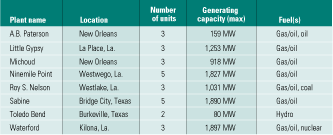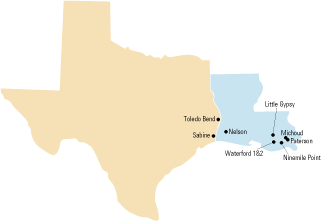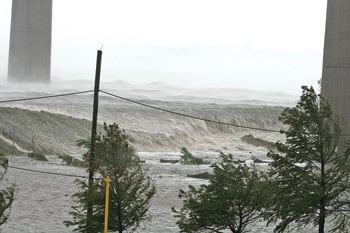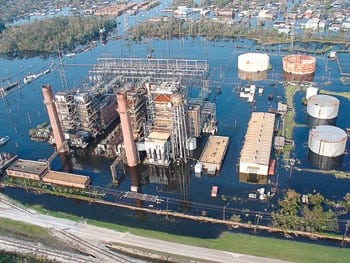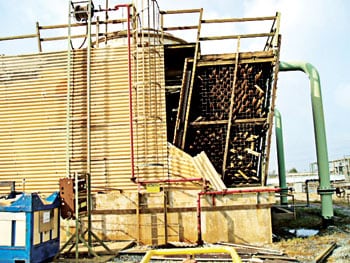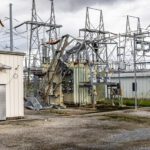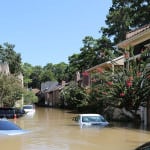The hurricane season of 2005 produced two of the most destructive storms in U.S. history: Katrina, a Category 3 hurricane that made its second landfall in Buras, La., on August 29, and Rita, a Category 3 that hit just east of Sabine Pass, Texas, on September 24. In the back-to-back strikes, Katrina and Rita pummeled the coastal regions of Mississippi, Louisiana, and Texas, causing record power outages and widespread transmission and distribution failures across Entergy Corp.’s service territory.
|
Table 1. Katrina: Timeline of events Source: Entergy
|
|
Table 2. Rita: Timeline of events. Source: Entergy
|
The majority of Entergy’s 30 fossil-fueled units in the hurricanes’ paths escaped major damage. Most were returned to service in a matter of days once repairs were completed and off-site power was restored (see tables and the map, Figure 1).
|
Table 3. Plants affected by the hurricanes. Source: Entergy
|
|
1. Eight was enough. The power plants affected by Hurricanes Katrina and Rita. Courtesy: Entergy
|
Two plants near New Orleans—Michoud and Paterson—experienced severe flooding from Katrina. Michoud was shut down the day before the storm hit, and Paterson already was out of service when Katrina approached. For several months following the storm, Entergy planned to keep both plants off-line indefinitely due to the low electrical demand in the New Orleans area; however, demand has rebounded and is about 70% of pre-Katrina levels today.
Because Michoud Units 2 and 3 later were designated “must run” units, Entergy switched gears and began making the repairs needed to return them to service. Michoud 2 was put back on-line on April 11, and Michoud 3 is expected to join it by the end of June. By the end of this summer, only Michoud 1 and all three units at Paterson (including a black-start unit intended to provide start-up juice to other plants in the area) are expected to remain off-line.
Wind damage and flooding, especially after Katrina, crippled communications systems and highways throughout the region, making it very difficult to obtain and transport essential supplies such as fuel, ice, food, and water. Even worse, 30 Entergy Fossil employees lost their homes to the storm; the company provided temporary living quarters for them and their families.
Preparation pays off
Despite unprecedented devastation and chaos in the aftermath of the hurricanes, the generating assets of Entergy’s Fossil Organization suffered far less damage than anyone would have anticipated. This was not due to luck, but rather to a solid emergency-response plan, including many procedures that are rehearsed every summer. Among the contributors to Entergy’s successful coping with the storm were the following.
Exceptional safety performance. Many plant staffers were required to work long hours and successive days without relief and often under stressful conditions. Despite the heightened potential for accidents, only one medical-attention injury resulted in Fossil Operations from both hurricanes. On October 6 an employee of the Nelson plant suffered first- and second-degree burns to his forearm and wrist after a 480-V circuit breaker flashed. The OSHA-recordable accident was attributed to equipment failure, not human error.
Strong management support. The Fossil Organization’s Emergency Response Center in The Woodlands, Texas (a suburb of Houston), was staffed around the clock to provide guidance and logistical support before, during, and after the hurricanes. Led by Etienne Senac, vice president of operations and fossil support staff, the Fossil Emergency Response Center worked closely with Entergy’s System Command Center in Jackson, Miss., to provide 24/7 help in procuring materials and services that were in great demand following the hurricanes: fuel, ice, generators, temporary living quarters, and cooking equipment. Entergy’s Virtual Resource Center helped mobilize employees of the Fossil Organization and other divisions as they were needed for restoration efforts.
Lines of communication maintained. Supervisors and managers at all fossil-fueled plants established contact with as many employees as possible to ensure that they were safe and to identify their food, water, shelter, clothing, and transportation needs. An Employee Infoline was set up to enable employees to report their status and ability to return to work. As part of its emergency plan, the Fossil Organization had previously purchased satellite phones for each plant. Those phones, employees’ mobile phones, and text messaging kept the organization in contact. The restoration of some local cellular phone service in the days following the hurricanes proved invaluable; during the storms, most satellite phones proved useless, because they required callers to go outside to use them. In the immediate aftermath of the hurricanes, management teams conducted multiple, daily conference calls to track plant status and to ensure that all collateral needs were addressed.
Some units switched to islanding mode. Single units at hurricane-threatened plants were isolated from the grid and placed in islanding mode, allowing them to power their own auxiliary systems upon loss of off-site power.
Workforce rebounded quickly. Fossil plants that did not flood became shelters for employees whose homes were rendered uninhabitable or who could not reach their homes on blocked roads. Entergy provided housing, transportation, and counseling for employees and their families. The Virtual Resource Center helped displaced employees find work at other plants and rounded up resources from different parts of the organization to augment recovery efforts at damaged sites.
T&D infrastructure repaired at record pace. Crews of company employees and contractors staged before the storms were dispatched to Mississippi, Louisiana, and Texas to assist with restoration efforts. Their fast and efficient work accelerated restoration of key parts of the transmission and distribution system, which in turn restored availability of off-site power to affected plants.
First came Katrina
Katrina made its second landfall at around 6 a.m. on Monday, August 29, near Buras, La., with sustained winds of 125 mph. It was the most destructive event in Entergy’s history, knocking out power to more than a million customers and decimating the coastal regions of Louisiana and Mississippi.
The Fossil Operations response to Hurricane Katrina was coordinated from the Emergency Operations Center in The Woodlands, which was activated on August 28 and staffed around the clock until September 7.
Fossil-fueled units in the New Orleans area that were in danger of flooding were isolated from the grid in advance of the storm. But little transmission capacity or load was left in the area once Katrina passed through.
The Michoud plant was brought off-line in anticipation of a catastrophic storm surge (Figure 2) and flooding. Core teams of employees remained at Michoud, Ninemile, Waterford 1 and 2, Paterson, and Little Gypsy during the storm to monitor equipment and assess damage once it became safe to go outdoors.
|
2. Wall of water. The 20-foot storm surge of Hurricane Katrina approaching the Michoud plant, as photographed by plant manager Don McCrosky. McCrosky, who at the time also managed the A.B. Paterson plant, now manages Entergy’s Little Gypsy plant. Courtesy: Entergy
|
Shutting down the Michoud units slowly, before Katrina hit, helped avoid dangerous consequences for employees and plant equipment. A private weather forecaster hired by Entergy predicted flooding in the New Orleans area, and the prediction became reality: Michoud—and the Paterson plant as well (Figure 3)—were submerged under six feet of water. Had Michoud remained operational, the risk of turbine fires and hydrogen explosions would have been great. With the plant in “lockdown” mode, employees were able to concentrate on personal safety, staffing, logistics issues, and damage assessment in the days following the hurricane.
All in all:
- Sixteen units (4,613 MW) were affected by Katrina. At the height of the hurricane, all either were shut down or isolated from the grid to protect equipment.
- Ten units (3,725 MW) suffered minimal or no damage and were operational or available for operation shortly after the hurricane.
- Six units (888 MW) suffered extensive flood damage and were not immediately available to return to service.
|
3. Six feet under. The A.B. Paterson plant a few days after Katrina hit. Courtesy: Entergy
|
Then, Rita hit
Hurricane Rita made landfall just east of Sabine Pass, Texas, at 2:30 a.m. on Saturday, September 24 with sustained winds of 120 mph. Once again, Entergy’s Fossil Operations response was coordinated from the Emergency Operations Center, which was staffed for a total of 13 days with 24-hour coverage from September 23 to October 5.
Based on lessons learned from Katrina, management of the Fossil Organization reduced the number of core team personnel at the Sabine site. Smaller core teams were stationed at the Sabine, Nelson, and Toledo Bend plants during the hurricane. Sabine was shut down in anticipation of flood damage. In the days following Rita’s landfall, the Nelson, Sabine, and Toledo Bend plants lost off-site power and operated on emergency generators until power was restored.
Nelson and Sabine experienced significant wind damage but no flooding. The cooling towers at both plants (Figure 4) proved vulnerable to high winds.
To summarize Rita’s impact:
- Fourteen units (3,599 MW) were affected. At the height of the hurricane, 12 units (3,143 MW) were either shut down or isolated from the grid to protect equipment. Two units (456 MW) remained on-line during the storm.
- Six units (1,034 MW) suffered minimal or no damage and were either operational or available for operation shortly after the hurricane.
- Seven units (2,353 MW) suffered varying degrees of damage. They have since been repaired and now are either operational or available for operation.
- One unit (212 MW) at Sabine was in a planned outage during Rita.
|
4. Very uncool. Wind, rather than water, was the major cause of damage from Hurricane Rita. Shown is the cooling tower of Unit 3 of the Sabine power plant in Texas. Courtesy: Entergy
|
Comparing the hurricanes’ impact
Entergy faced different restoration challenges following the hurricanes. But the lessons learned during Katrina helped the Fossil Organization gear up quickly for Rita and anticipate many needs well in advance. These included preparing adequate supplies and provisions, arranging logistics and support, and adjusting core team staffing levels at each plant in the storm’s path.
Katrina left a record 1.1 million customers without power in Mississippi and Louisiana. The storm surge and flooding it caused spurred a mass evacuation of New Orleans and surrounding parishes and prompted Entergy to temporarily relocate its corporate headquarters to Clinton, Miss.
Rita left 800,000 customers without power, mostly in Louisiana and Texas. But although Rita was weaker than Katrina, it did much more damage to transmission lines and equipment. In the days immediately following the storm, 82% of Entergy’s transmission system in Texas and 38% of its transmission system in southwest Louisiana was out of service.
The widespread destruction of T&D lines and equipment left Entergy with no choice but to institute a series of rolling blackouts near Houston while the company worked to return the 12 affected fossil-fueled units to service and complete transmission repairs. In about a week’s time, the majority of fossil units were returned to operational status, ready to supply power to the grid.
Flooding at Michoud and Paterson
The decision to shut down Michoud before Katrina hit left 17 employees at the plant. At that time, there were 12 employees at the nearby Paterson plant, which was not in operation; their primary responsibility was to maintain its black-start unit. Paterson was considered less vulnerable to flooding.
The core teams at Michoud and Paterson established headquarters in the control rooms, because they are at higher elevations within each facility. To address the possibility of water reaching the 20-foot level, backup locations at even higher elevations were designated as places where staffers could safely ride out the hurricane if flooding proved severe.
As it turned out, Paterson flooded just as badly as Michoud, and the former plant lacked enough provisions to sustain a dozen people for several days. Paterson employees quickly ran short of essentials and had begun to ration food and water when it was decided to evacuate them by helicopter on August 31. After a few days, Michoud also began running short on provisions, and helicopters again had to be used—this time, to fly in food, ice, and water.
In the days following Katrina’s landfall, law enforcement and medical services were largely nonexistent in the New Orleans area. Widespread looting and criminal activity were reported. According to Mary Lancaster, manager of the Ninemile plant, a few days after the storm, a rumor spread that an armed mob was sighted heading from a nearby substation to the plant gate. Although the rumor proved unfounded, deteriorating security conditions in the greater New Orleans area convinced Entergy management to evacuate employees from Michoud by helicopter on September 3.
Once the storm and the security threat had passed, Michoud employees organized into teams and began assessing the toll on plant equipment. Except for some metal siding that had been blown off the elevator shaft and boiler, they found little structural damage to the plant.
However, most employee vehicles and emergency generators, and the restrooms located near the ground floor inside the plant, were lost to the flood. As soon as the waters receded a few days later, Michoud employees designed and built makeshift showers and restrooms. They also repaired a company vehicle that had been parked inside the plant and overhauled one waterlogged emergency generator so it could supply power to the control room, where they were living 24 hours a day.
At Michoud, the initial post-storm strategy was to minimize expenses. But as it became clear that considerable demand would be lost with the mass departure of New Orleans residents, the strategy shifted from restoration to preservation. The main enemy was identified as salt-water corrosion of pumps that had been submerged in six feet of brackish water. All major pumps and motors were pulled and sent out for cleaning.




